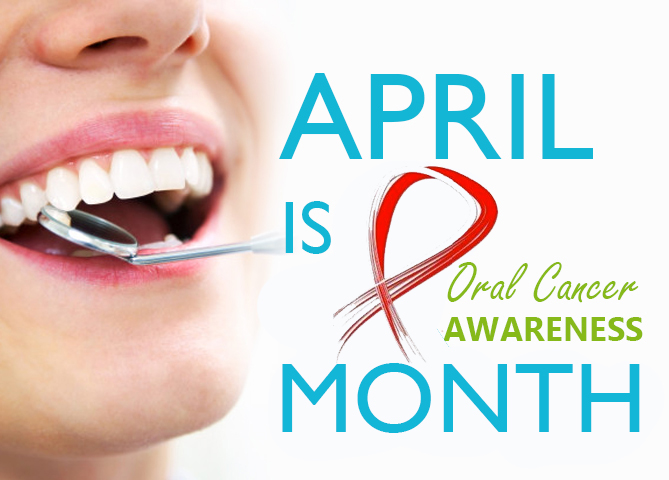
by Roseman Dental | Apr 11, 2016 | Dental Clinic Blog, Oral Health, Roseman Dental - NV, Roseman Dental - UT
A Guide to Symptoms and Signs in Your Mouth
The term “oral cancer” is actually a broad term that covers several different types of cancers that might affect your lips, mouth, nose, larynx, and throat (the oral cavity). While these cancers don’t garner as much attention as breast cancer or lymphoma, they are still very dangerous.
The Oral Cancer Foundation reports that over 54,000 Americans will be diagnosed with oral, larynx, or pharyngeal cancer this year, and only slightly more than half of those diagnosed will still be alive in five years—a number that has not significantly improved in the last few decades, even as survival rates increase for other cancers.
“Part of what makes oral cancer so dangerous is the difficulty in diagnosing the disease,” said Dr. Aaron Ferguson, Director of Public Health Sciences Education and Assistant Professor at Roseman University of Health Sciences’ College of Dental Medicine. “The symptoms might not produce pain or other obvious signs, or might mimic other conditions and thus go untreated and undiagnosed until the cancer has reached a more advanced stage.”
This is especially true for patients who don’t have a “dental home”, according to Ferguson. A dental home is a specific place where a patient routinely visits the same dentist. Often the visible signs of developing oral cancers can be identified by a dentist, but it is much easier for the dentist to notice changes if he or she has been seeing the patient over a long period of time. For patients who rarely or never visit the dentist, or frequently change dental care providers, these subtle changes are harder to spot.
In addition, a new virus called HPV16 has contributed to a rise in oral cancer cases that manifest in the back of the mouth and throat, and often don’t produce visible lesions or discoloration that dentists can readily identify as a warning sign.
How to Check for Oral Cancer
There are a few signs you can look for to identify oral cancers, and along with regular dental checkups and screenings these things can help you spot cancer earlier and get proper treatment. These signs include:
- Mouth sores that don’t heal
- Lumps or thick skin in the lips or soft tissue inside your mouth
- White or red patches on the inside of the mouth
- Loose teeth
- Changes to the way dentures fit
- Tongue, jaw, or throat pain
- Difficulty or pain when swallowing and chewing
- A lump or feeling of something caught in your throat
“If you notice any of these signs, call your dentist immediately,” advises Dr. Ferguson. If you don’t have a dentist you can visit the Dental Clinic at Roseman University in South Jordan for affordable, high quality care by Doctor of Dental Medicine students and faculty.
Lowering Your Risk for Oral Cancers
In addition to checking for oral cancer, there are things you can do to help lower your risk of developing the disease.
- Quit smoking and immediately stop using any type of tobacco, including cigarettes, cigars, pipes, chewing tobacco, and snuff
- Avoid excessive alcohol consumption
- Eat a diet with lots of fruits and vegetables
- Protect your lips with a lip balm that includes SPF whenever you are going to be out in the sun
- Get checked for the sexually transmitted virus human papillomavirus (HPV)
- Find a “dental home” and get regular checkups and screenings from your dentist, especially if you are over the age of 40 and have any other potential risk factors
Oral cancer treatments generally include a mix of surgery, radiation, chemotherapy, and targeted drugs depending on the location and stage of the cancer, as well as your overall health.
While you may not be able to control all your risk factors, understanding the dangers of oral cancer and getting regular screenings can help you discover and diagnose it at an earlier stage, which often leads to better outcomes.
by Roseman Dental | Apr 7, 2016 | Dental Clinic Blog, Oral Health, Roseman Dental - NV, Roseman Dental - UT
If you’re looking for ways to improve the health of your entire body, open your mouth and say “ahhhhhh.” Medical research has shown that individuals with gum disease have an increased risk of other health issues, such as heart disease and even cancer. Learn how bad oral health impacts the body and what you can do about it.
The True Impact of Gum Disease
Early signs of gum disease include swollen gums, chronic bad breath, gums that bleed while flossing and sensitive teeth. Your mouth acts as an internal interstate to the rest of your body, and the disease in your gums can use that interstate to spread to the rest of your system. Additional health complications that can result from gum disease include stroke, low birth weight in babies and other health complications. Now that you know the how, it’s time to learn more about the what, as in what you can do to reduce the harmful effects of poor oral health.
It All Starts in the Mouth
Besides keeping up with your oral hygiene, there are several additional things you can do to improve your overall physical health. One of the first things you should do is add more minerals and healthy fats to your diet. While you’re at it, you should ease up on foods with an abundance of sugar and vegetable oil.
To boost your immune system to fight off any disease you might already have and future disease, make sure you get plenty of sleep, handle your stress well and cut out bad lifestyle choices, such as smoking and excessive drinking.
Pay Attention to the Oral Products You Use
Using oral products won’t do you or your health much good if those products contain toxins that can counteract your preventative measures. Look at and research the ingredients in your toothpaste, mouthwash and chewing gum to make sure they’re as beneficial as their makers claim or talk to your dentist about what products s/he would recommend.
Take full control of your health, starting with your teeth and gums. Ask your dentist for more tips.
by Roseman Dental | Mar 30, 2016 | Dental Clinic Blog, Dental School, Oral Health, Roseman Dental - NV, Roseman Dental - UT
While you might have a basic understanding of tooth decay, there’s likely much about the topic you don’t yet know. A deeper understanding of your oral health allows you to know when you have a problem that is likely to take care of itself and when you have one that requires a professional treatment from a dentist. Learn more about tooth decay and how to take the best care of your pearly whites.
Age Makes a Difference in Tooth Decay
One of the first things to know about tooth decay is that it’s more common now than ever in children and babies. A child’s teeth aren’t as developed or strong as an adult’s, so acids, plaque and bacteria will eat away at their teeth. Eating and drinking habits for small children also impact oral health, with many parents not realizing the harmful effects of giving a child a bottle or sippy cup filled with milk or juice when they go to sleep, or to drink throughout the day. Snacking on things like fruit snacks, starchy crackers, or sugary treats throughout the day—called “grazing”—is also harmful to a child’s teeth.
Recognizing the Signs of Tooth Decay
Knowing what tooth decay looks like is another essential component of treating it. Indications of tooth decay include:
- Discolored teeth
- Bad breath or a bad taste in your mouth
- Inflammation of the gums around a sore tooth, which is also a sign of an abscessed tooth
- An ongoing or recurring toothache
Properly Diagnosing Tooth Decay
To rule out an abscess and anything else that might be going on with your teeth, your dentist will make sure you actually have tooth decay in order to prescribe proper treatment. You’ll likely be asked questions about your medical and dental history before the dentist uses a small mirror to examine your teeth. You might also have X-rays taken of your mouth and teeth to better pinpoint which of your teeth may be decayed. Common treatments for tooth decay that has worked through tooth enamel include fillings, crowns, tooth extraction and root canals.
Oral health is a large component of your overall health. By taking good care of your teeth, you’re taking equally good care of the rest of your body as well.
by Roseman Dental | Mar 15, 2016 | Dental Clinic Blog, Oral Health, Roseman Dental - NV, Roseman Dental - UT
Do you actually go to the dentist twice as year, as many dental professional recommend? If not, you should really be scheduling routine dental exams often. There are numerous benefits, and you are putting your oral health at risk by not having a professional regularly examine your teeth and gums. Here are just a few reasons why you should schedule dental appointments twice a year.
Check for Oral Health Problems
Unless something is really hurting you, then it is likely that you will remain unaware if a problem is developing within your teeth or gums. Gum disease can sometimes start off as asymptomatic, but become far more serious if it’s not treated. A professional dentist will be able to detect any problems, big or small, and recommend the most appropriate treatment. X-rays may also be taken to see if any issues are growing out of the dentist’s sight.
Thorough Teeth Cleaning
You should be brushing twice a day and flossing once daily, but even that is not always enough to stop the spread of plaque. Dentists have higher-quality tools to remove plaque and tartar. In addition to eliminating tartar, your dentist will also polish the teeth to help eliminate surface stains. You cannot get this level of cleaning at home, and it is a huge benefit if you get a professional cleaning twice yearly.
Recommendations in Your Oral Healthcare Routine
After examining and cleaning your teeth, your dentist will tell you if there is anything you need to change in your oral healthcare routine, such as brushing more often or adding flossing to your routine. A dentist may also see that you are brushing every day, but you are doing it incorrectly and can show you how to brush properly.
The combination of daily dental cleaning and professional check-ups every so often will increase your chances of healthy teeth throughout your life. If it has been a while since your last visit to the dentist, then schedule one at your earliest convenience.

by Roseman Dental | Mar 14, 2016 | Dental Clinic Blog, Dental School, Roseman Dental - NV, Roseman Dental - UT
The recommendation that you visit your dentist at least twice a year certainly isn’t anything new, but when you get to your dental office you might notice that there are several things that are changing about the way you receive care and interact with the staff and the dentist. Today’s dentists are increasingly embracing technology as a way to offer a higher level of care and a more streamlined visit. Here are just a few of the trends you might see next time you visit your dentist.
Minimally Invasive Treatments
You might not believe it, but dentists don’t like drilling your teeth any more than you like having them drilled. Fortunately with advances in dental technology and treatment methods, more and more procedures can be performed in a way that is “minimally invasive”. The goal with these treatments is to conserve as much of your healthy tooth structure as possible, removing the least amount of natural tooth to achieve a long-lasting positive result. Fixing crooked teeth and other malocclusions has also become easier and less invasive with products like Invisalign®, while advances in treating cavities and other oral health-related problems have led to better and longer-lasting outcomes.
Dental Implants
Another improvement to dental treatment in recent years is the more widespread use of dental implants to improve the appearance and function of your teeth without damaging or impacting the teeth that surround it. Dental implants or implant-supported dentures have quickly become a popular option for many people who have damaged or missing teeth, although they are not an option in every case. Visit The Dental Clinic at Roseman University to find out more about dental implants if you think you might be a candidate.
Technology in the Dental Office
Rapid advances in technology have impacted the way we do business, the way we communicate, and our overall health and wellness—including dental health. Today many dentists are using digital CAD/CAM technology (computer-aided design/computer-aided manufacturing); with a small wand about the size and shape of an electric toothbrush, your dentist can create a digital image of your mouth and the shape of oral structures inside.
“Traditional impressions that record the shape and configuration of teeth and mouth can often be replaced with scans from laser or LED light cameras. The digital file is sent to a 3D printer or milling machine to create a model made of lightweight, durable resin,” said Dr. Doug Ashman, a professor at Roseman University College of Dental Medicine. “The advantage of this approach, beyond the obvious improvement in the patient’s comfort, is the increased accuracy of the digital impression and the ability to store and retrieve the image at a later time, as needed.”
Similar technology can be used to create crowns and fixed bridges, and with the help of sophisticated software, the dentist can create a uniquely designed and perfectly shaped crown ready for implant, often in just a matter of minutes while the patient waits in the dental chair.
Other technology you might start to see at your dental office includes software and apps that allow you to schedule appointments with ease, fill in your health history prior to arriving at the dentist’s office, and get things like text and voicemail reminders when it’s time for your appointment.
While the trends in dental medicine are improving the way patients receive treatment and interact with their dental office, there is one trend that is never going away: having a healthy smile and a healthy mouth will always be in style.
by Roseman Dental | Mar 10, 2016 | Dental Clinic Blog, Oral Health, Roseman Dental - NV, Roseman Dental - UT
Oral hygiene is important for people of all ages. Young children, in particular, can benefit from good oral health habits. Setting good habits with your children can improve their overall health and prevent oral problems like cavities and gingivitis, so use these tips to teach children effective habits.
Brush and Floss Daily
Children should understand the importance of brushing and flossing at a young age. These simple activities are the best ways to prevent tooth decay. Regular brushing helps to remove plaque build up on the teeth, while flossing helps remove food and residue that is lodged between the teeth and underneath the gums.
To help your children with brushing and flossing, make sure they have the right tools. You can purchase floss and toothpaste made specifically for children, and parents should help children with brush until the child has the manual dexterity to tie their shoes. Also, make sure to change out their toothbrushes regularly.
Eating a Balanced Diet
Poor eating habits can contribute to oral health problems. It is especially important to limit the amount of starchy and sugary foods your child consumes. These foods can cause plaque to build up on the teeth, and they are one of the main causes of decay. If your child does consume these foods, have them rinse their mouth with water after eating. It is also a good idea to give your children drinking water with fluoride.
Visit the Dentist
Part of establishing good oral hygiene with children involves visiting the dentist. You can schedule regular checkups with the dentist for a thorough cleaning and inspection. It is also important to visit the dentist if your child experiences a mouth injury or loses a tooth.
When you establish good oral health habits, your children will be less likely to develop cavities or gum problems. It is important to implement these tips sooner rather than later because as your children get older, they need to understand and practice good oral hygiene on their own.




